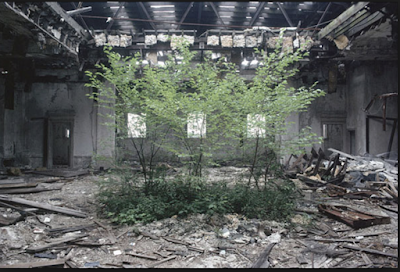 |
| These ads, targeted at black males, where found throughout the blighted ruins of urban American cities in the mid-1990s |
Vergara is a committed leftist. He lets slip one of the reasons why the magnificent buildings of yesterday are allowed to decline into nothing more than degraded memories of stone and steel, when he wrote:
Black and Latino elected officials are reluctant to commit scarce resources to reclaim buildings that once welcomed people of color only as shoeshine boys, elevator operators, janitors, foundry workers, and maid. (p. 13)All of those vocations provide admirable, honest work, but in the absence of white people - who built the buildings and sustained an economy providing these service positions - the only remnants of their civilization for the now majority population of people of color are the buildings and structures they lack the mental acumen to understand how to maintain from the cruel elements of time and neglect.
There is one passage in American Ruins fitting for our current year, where enthusiasm and anticipation for Black Panther is whipping black people up into absolute hysteria, a zeal for the fictional world of Wakanda where blacks have developed the most technologically advanced civilization in human history.
Reading American Ruins and looking upon the blight and dilapidated structures Vergara's documents in melancholy photos (built long ago by white people who subsequently abandoned their cities when migrating blacks from southern states made living in them an untenable proposition) helps clarify the lie black labor built the United States.
Indeed, once white people abandoned Newark, Detroit, Camden and other northern cities, the now majority black population became stewards of a civilization they believe themselves to not only superior to, but whose unacknowledged labor they feel is directly responsible for creating.
In reality, the collapsing structures (white people long ago built) and edifices of once magnificent buildings is but a reflection of the collective capacity for civilization represented in the now majority black population who resides in places such as Newark and Detroit:
On New Year's Day 1995 in the Central Ward of Newark, I saw the first of many billboards depicting the solitary but anguished hollering face of a young black man placed horizontally along with a line of text. The image was unforgettable, and its location, among the abounded buildings and empty lots, acknowledged a national tragedy just where it was most intensely felt. The billboard, like a patch, seemed to be holding together the derelict structures supporting it.
I saw the face as I traveled to Chicago, Detroit, and New York City. The billboards came with different texts. I preferred the one with the words "Your mother" in large letters at the top. I interpreted the phrase as referring to all that had once been nurturing: the neighborhood, the buildings, the people, even the earth itself. For a while I ignored the rest of the sentence, but below the face the text continued "...Didn't raise you to be a drunk." The other version said, "Dead men can't jump," with "Don't drive drunk" below the image.
This was not a work of environmental art in the tradition of Robert Smithson, Jenny Holzer, Barbara Kruger, or Dennis Hollier. I had come across an ad campaign, a public-service announcement designed to discourage young black men from excessive drinking. The ads were sponsored by Coors Brewery, Vibe, the Box, and Black Entertainment Television and designed by Uniworld Group, a New York-based, black-owned advertising agency. These billboards had long been rented for beer advertisements for Coors, and Coors donated the remainder of their leases to this extraordinary example of shock advertising.
Ghettos are full of glamorous images that encourage people to drink and smoke. Designers at Uniworld Group and black community leaders in Nw York City emphasized that alcoholism among young black males was a serious problem, and the signs were designed to grab the attention of this group. This campaign, they felt, was a step in the right direction. In explaining the election of ghettos for the placement of the signs, Byron Lewis, the chairman of Uniworld, stated, "We were not hired to communicate to the white community."
It is doubtful that such signs would have been allowed in more affluent black or mixed neighborhoods. They were yet another symbol that visually defined ghettos, giving a symbolic cry to the most desolate of them. The billboards are gone, but I can still imagine a chorus of piercing screams coming from hundreds of huge open mouths all hollering together. (p. 198 - 199)Wakanda isn't real; but the ruins of white Americans civilization, courtesy of a racial group lacking in all self-awareness, is tragically too real.















